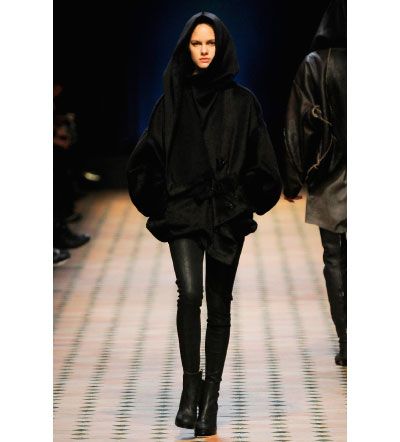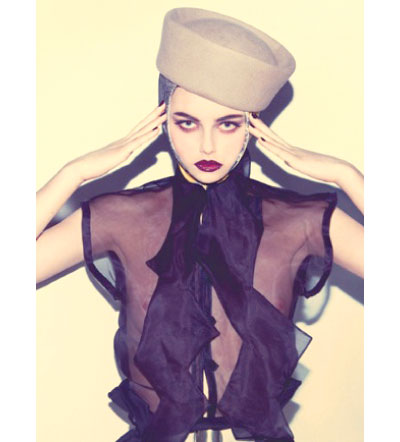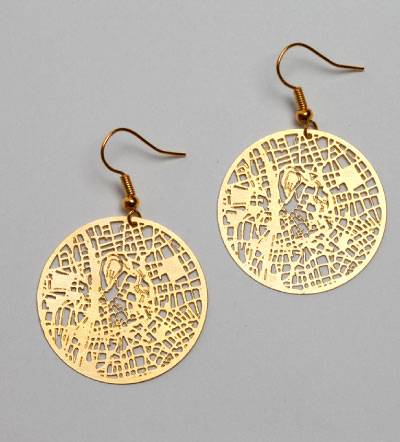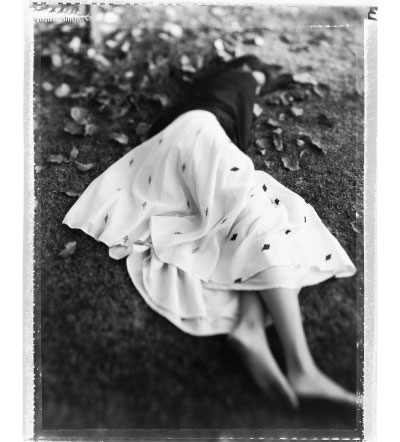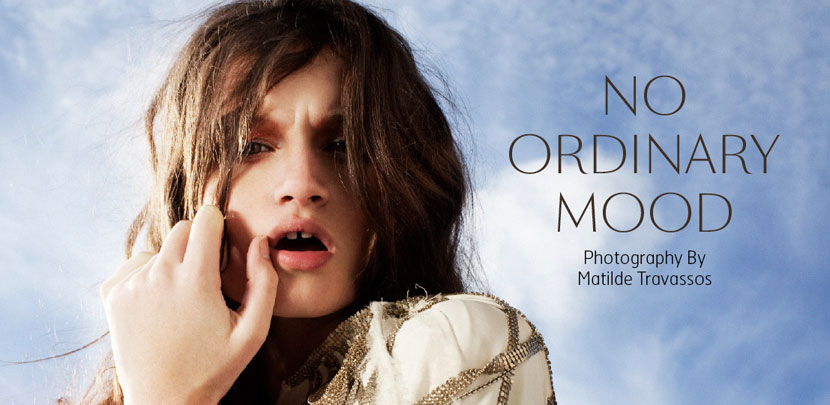![]() Despite its perennial reign at the pinnacle of French fashion, the storied house of Chanel has never shied away from venturing beyond its Gallic boundaries for inspiration. During Coco Chanel’s lifetime, her growing wealth and social status allowed her to flit around the globe, immersing herself in myriad aspects of foreign culture later to be distilled in future collections. Mademoiselle’s affinity for the Ballets Russe and the opulence of Byzantine jewelry resulted in a Russian influence that emerged in her designs. The historical link between Chanel and Russia provided the catalyst for Paris-Moscou, the house’s 2008 Métiers d’Arts collection which lies at the center of Karl Lagerfeld: Chanel’s Russian Connection, a book that was released last year by Steidl.
Despite its perennial reign at the pinnacle of French fashion, the storied house of Chanel has never shied away from venturing beyond its Gallic boundaries for inspiration. During Coco Chanel’s lifetime, her growing wealth and social status allowed her to flit around the globe, immersing herself in myriad aspects of foreign culture later to be distilled in future collections. Mademoiselle’s affinity for the Ballets Russe and the opulence of Byzantine jewelry resulted in a Russian influence that emerged in her designs. The historical link between Chanel and Russia provided the catalyst for Paris-Moscou, the house’s 2008 Métiers d’Arts collection which lies at the center of Karl Lagerfeld: Chanel’s Russian Connection, a book that was released last year by Steidl.
Conceived as a way to celebrate the specialized work of Chanel’s satellite ateliers, Métiers d’Arts collections are notably rich in detail. For Paris-Moscou, however, powerhouse head designer Karl Lagerfeld exceeded expectations, featuring a steady stream of Russian models, military-inspired menswear, glittering matryoshka doll appliqués, and towering jeweled headdresses.


 On a pleasant afternoon last, January Damir Doma, the young fashion designer who works in Paris, sat at a long table in his boutique-cum-showroom located in a tiny alley of Le Marais, Paris’s fashion district. He looked content. His men’s show that took place the night before was well received and the nail-biting, repeated-click anxiety that every designer goes through after the show, has passed.
On a pleasant afternoon last, January Damir Doma, the young fashion designer who works in Paris, sat at a long table in his boutique-cum-showroom located in a tiny alley of Le Marais, Paris’s fashion district. He looked content. His men’s show that took place the night before was well received and the nail-biting, repeated-click anxiety that every designer goes through after the show, has passed.The showroom was swarming with buyers from all over the world, and Doma’s assistants, all young and lanky, were busy filling out orders, chatting in half-a-dozen languages — I discerned French, English, Italian, and Russian. The courtyard served as a smoke-break gathering place and sandwiches were laid out for the hungry.
Doma is a hot new name among the young fashion cognoscenti and his ethereal, monochromatic menswear has already been copied high and low. Last fall, as I was chatting with Susie Bubble, the famous English fashion blogger, one of her entourage broke in asking if my coat was by Doma (it wasn’t).
Doma’s show, held at a parking garage, was a mob scene with hangers-on of all stripes trying to get inside to see what the designer cooked up this time.


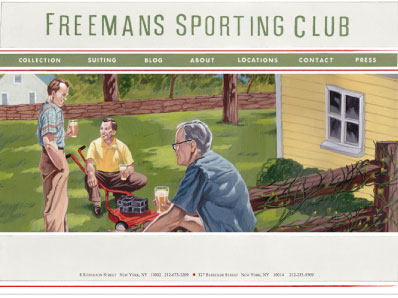

![]() Susan Sontag once said that an off-putting contemporary cultural phenomenon may become endearing with the passage of time. And while the ’50s Americana, conservative and conventional, has disconcerted many a person of liberal views, today its trappings have been adopted by a growing army of hipsters who would not touch suits and dress shirts, traditionally reserved for the gray Wall Street drones, with a ten foot pole just a decade ago. Freemans Sporting Club, the men’s Lower East Side store — pardon, a haberdashery! — has been instrumental in pushing this style, along with the nostalgic “hand-made-in-the-USA” tag.
Susan Sontag once said that an off-putting contemporary cultural phenomenon may become endearing with the passage of time. And while the ’50s Americana, conservative and conventional, has disconcerted many a person of liberal views, today its trappings have been adopted by a growing army of hipsters who would not touch suits and dress shirts, traditionally reserved for the gray Wall Street drones, with a ten foot pole just a decade ago. Freemans Sporting Club, the men’s Lower East Side store — pardon, a haberdashery! — has been instrumental in pushing this style, along with the nostalgic “hand-made-in-the-USA” tag.
Nostalgia notwithstanding, we live in modern times, and so Freemans recently launched their website. Staying true to the brand image, the website is a carefully executed time-machine that transports you from today’s Williamsburg to the Suburb, USA of the yesteryear. The website features cheeky images of suburban pastoral in the Norman Rockwell style — here are a couple of Dads sipping beer around a lawnmower while a younger guy is working on his trusted motorcycle and there is another Dad taking his son fishing.
The merchandise matches the image — three-piece suits hand made in Brooklyn, oxford shirts made in New Jersey (albeit from Japanese cotton) — all are timeless, as the website assures. And do not forget the jeans — raw indigo selvage denim, of course! All fine and dandy, but what would Allen Ginsberg say about flannel suits and the best minds of his generation?

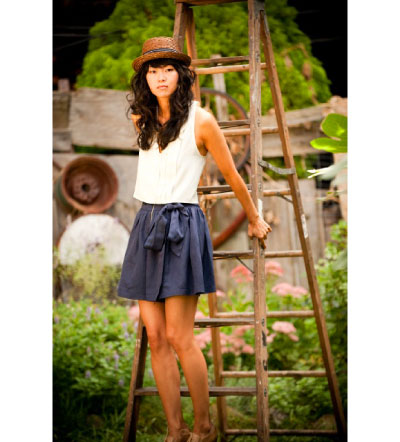
Avril Top and Mimi Skirt. Photography courtesy of Annie Havlicek
She complicates the collection by adding to the overtly femme pieces a few preppy, masculine touches — structured shorts, skirts, and jackets as well as smartly tailored pants which reach to just below the knee. Havlicek coyly refers back to her source of inspiration by topping off the collection with a straw boater hat. With this collection and a newly established boutique, Havlicek confirms all early signs that she is a true talent and will make her mark on the fashion world.
Annie, Havlicek’s first boutique opened this past Saturday at 154 Orchard St. in the Lower East Side.


The end result is highly structured shoulders on fitted dresses, jackets, a one-piece jumpsuit, and multifaceted skirts that jut away from the body creating a diamond-like shape similar to the stars that surround Ekrelius’s imagined space goddess. His detailed construction gives the collection a strong, authoritative presence, but paired with organza and silk the collection retains a distinct femininity.
The prints for “Stardust” complete the Stargazer story — brightness bursting through darkness, streaks of grays and yellows against dark backdrops. In this, Ekrelius successfully binds future to past; couture with ready-to-wear.

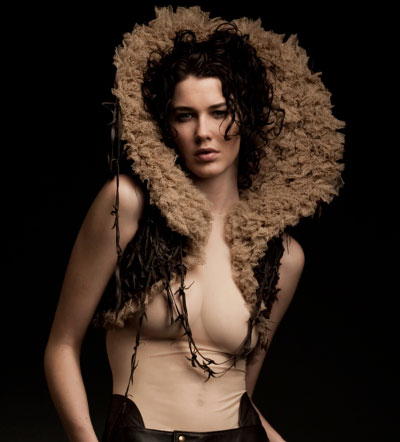
Photography by Diego Indraccolo, Model: Kirsten Varley, Styling: Kay Korsh
Rachel Freire missed her calling as a costume designer, but she fits right in with – or speeds ahead of – her aesthetic contemporaries, in both innovation and imagination. Freire graduated in 2006 from Central Saint Martins, where she studied Design for Performance rather than fashion design. She was “more interested in the psychological aspects of how people perceive dress”. Her latest collection for Fall/Winter 2010 particularly demonstrates her interest in testing limits and soliciting audience reaction. Freire, who labels her design aesthetic “Period drama meets Blade Runner”, excels in manufacturing futuristic beauty. Her sci-fi designs include jeweled headpieces; nude-colored, detailed bodysuits; and an oversize mirror-plated bolero that resembles a football player’s shoulder pads. Precise ruching, exaggerated ruffles, and minor elements of corsetry make Freire’s clothing veritable desserts made of silk and mirrorball pieces. Detailed but durable, the visionary’s conceptual looks are Gaga-ready, but still hint heavily at traditional influences and sophisticated techniques. Freire’s appropriate drama derives from theater, of course, and from her favorite designer, Thierry Mugler. Indeed she has a head start on filling the void that Mugler left when he stopped designing. Practically every item in this collection boasts an extravagance and depth that blur the line between clothing and accessory. Freire says she designs for “daring people, definitely…someone who wants to stand out.”

Physical places have an uncanny way of evoking nostalgia. Maybe it’s the street corner in New York where you first met your significant other or the club you went to practically every weekend that semester you studied in Berlin. It could be your childhood home, the campus of your alma mater or even that park in Copenhagen you spent one perfect day just lounging in—whatever the place or connection, our most visceral memories are inextricably linked to their locales.
Fluid Forms, an Austrian design firm, has come out with a design called Streets Earrings that allows anyone to adorn themselves with a satellite street map of any location in the world—a physical reminder of one’s best memory. In a process similar to developing photos, thin metal sheets are photo etched with satellite images of a location selected by the customer. The result is a delicately engraved satellite map, enclosed in a simple, dangling hoop.
Hannes Walter and Stephen Williams, co-founders of Fluid Forms, collaborated with New York-based urbanist and designer John Briscella to make the Streets designs. The series came after the firm’s initial line of custom products, which are all based on topographical maps of the Earth. “Realizing that our Earth concept often doesn’t work in large cities, which tend to be flat, we had been looking to something that would work well in cities for a while,” writes Williams vie e-mail. “Urbanism is becoming a trend, and since a lot of emotions are tied up to locations within cities, the streets concept became the perfect extension to the Earth concept.”



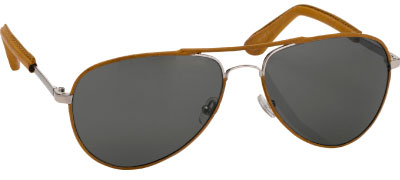

![]() When creative fashion designers such as Yohji Yamamoto or Raf Simons want to try their hand at creating sunglasses, they call on Simon Jablon, the owner of the London-based eyewear brand Linda Farrow. The company boasts an unparalleled heritage. It was established in 1970 by Jablon’s mother, whose name the line carries today. Linda Farrow started out as a fashion designer, before realizing that she could approach eyewear the way designers approach fashion, putting a creative spin on a quotidian product. The London scene quickly caught onto her quirky designs, and Farrow became their go-to brand for sunglasses. Remember those famous wraparound shades that Yoko Ono wore in her photos from the ’70s? They were Linda Farrow.
When creative fashion designers such as Yohji Yamamoto or Raf Simons want to try their hand at creating sunglasses, they call on Simon Jablon, the owner of the London-based eyewear brand Linda Farrow. The company boasts an unparalleled heritage. It was established in 1970 by Jablon’s mother, whose name the line carries today. Linda Farrow started out as a fashion designer, before realizing that she could approach eyewear the way designers approach fashion, putting a creative spin on a quotidian product. The London scene quickly caught onto her quirky designs, and Farrow became their go-to brand for sunglasses. Remember those famous wraparound shades that Yoko Ono wore in her photos from the ’70s? They were Linda Farrow.
The company was successful through the ’80s and then slowly drifted out of sight. It wasn’t until Jablon stumbled upon Farrow’s archive that a light bulb went off in his head. Thus, the company was resurrected. “What makes the company unique,” Jablon said when we caught up at Pitti Uomo in Florence, “is that there was never any business plan behind restarting it. As a child I could never quite grasp my mother’s achievement because you don’t think about your parents in terms of their career. The whole thing happened by chance. One day I was helping out my father, who asked me to clean out our family warehouse. So, I went over there to go through my mother’s stuff. There were boxes upon boxes of samples, and only after handling the eyeglasses I realized that I stumbled upon a treasure.”

Somewhere along the line luxury became a dirty word, and Karl Marx had probably less to do with it than Tom Ford. Contemporary consumer culture now champions oversexed logo-ed bling over subdued elegance. But there exist designers who aim to produce garments that are neither cocaine cocktail dress or the power suit. Rather, they are interested in making clothes that are real, not role-play, while conserving artisanal techniques that are slowly fading away as mass-production gains speed.
Lost & Found, a small fashion company whose design studio is hidden in the Tuscan countryside, was founded by Ria Dunn, a Canadian expat, in order to produce clothes based on the organic relationship between the maker and his craft. According to a statement on her website, “This intimate work is designed and made entirely in Italy and is produced by the old hands of those still carrying with them the spirit of ‘hand made’ craftsmanship.”
This intimacy is evident in the men’s and women’s garments Dunn produces, from carefully selected natural materials, such as cashmeres and wools interwoven with hemp and linen fibers, down to hand-finished stitching. The results feel earthy and organic. The textures are neither overly soft nor rough. This combination lured Karlo Steel, the buyer from Atelier, to Lost & Found.







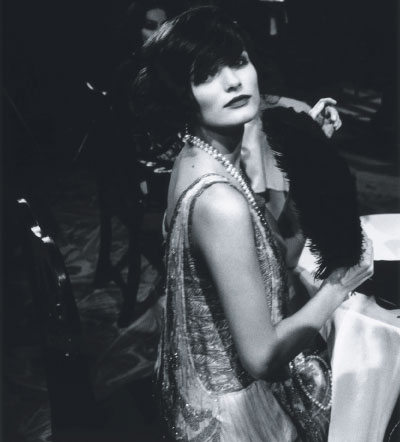
 Facebook
Facebook Permalink
Permalink Digg
Digg Reddit
Reddit LinkedIn
LinkedIn StumbleUpon
StumbleUpon Tumblr
Tumblr